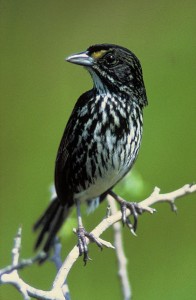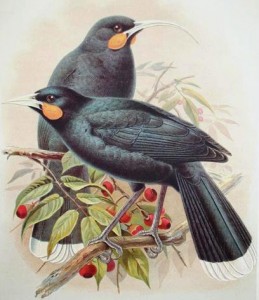Sounds of Extinct Birds
Ever wondered what a Dodo sounded like? Or a Great Auk? Or a Kaua’i ‘O’o?
On a whim, I went looking for sounds of extinct birds on the internet, and I found a lot more than I bargained for — in more ways than one. I managed to turn up some of the rarest, most remarkable, saddest and most haunting recordings I’ve ever heard…and also some of the looniest. I’ll save the loony for last; let’s start with the poignant.
Dusky Seaside Sparrow

On its Florida Bird Sounds page, the FMNH posts links to .wav files of the songs of many Florida Birds, including the Dusky Seaside Sparrow (Ammodramus maritimus nigrescens), of which the last individual died in captivity in 1987 at Walt Disney World. You might argue that they weren’t amazing songsters, but I rather like their style. In addition to the FMNH site, the Macaulay Library has an extensive collection of Dusky Seaside Sparrow recordings.
Ivory-billed Woodpecker
Macaulay also has a number of other extinct bird sounds. One of its crown jewels is, of course, Arthur Allen’s famous 1935 recording of Ivory-billed Woodpeckers (Campephilus principalis) in Louisiana. Interestingly, a search in the Macaulay catalog for “Ivory-billed Woodpecker” also turns up John Dennis’s 1968 recording from Texas, a cut that has been the subject of much debate — see the “Notes” section of the linked page for a hint of the history of the discussion.
Bachman’s Warbler
This was one of my most exciting finds. Both the Macaulay Library and the Borror Lab have copies of the two known recordings of Bachman’s Warbler (Vermivora bachmanii), from 1954 and 1959, some of the species’ final years. One of the reasons I find the song of this species so fascinating is that it contains more than an echo of the more familiar sounds of its surviving relatives, the Blue-winged and Golden-winged Warblers. In short, in spite of everything, it sounds ordinary — which just makes it the more remarkable.
Hawaiian Birds
It’s not surprising that Hawaiian birds should make up a good percentage of the extinct species for which recordings exist: first, because Hawaii has lost so many species (around 35 since 1800) and, second, because a number of those extinctions have occurred in recent years, during the era of audio recording. Here is a sampling of Macaulay’s treasures:
- Kaua’i ‘O’o (Moho braccatus), last heard 1987: eight cuts, seven online
- Po’ouli (Melamprosops phaeosoma), extinct since 2004: one cut online
- Hawaiian Crow (Corvus hawaiiensis), extinct in the wild since 2002: five cuts online
There may well be other extinct Hawaiian bird recordings out there, but I didn’t have time to track down any more. Note that the Borror and Macaulay search functions, and likely other internet searches as well, often have difficulty with the apostrophes that are ubiquitous in Hawaiian bird names, so searching the scientific names tends to work much better.
Spix’s Macaw
Xeno-canto has a couple of recordings of the last wild individual Spix’s Macaw (Cyanopsitta spixii) from the year 2000. Like the Hawaiian Crow, this species persists in captivity, so hopefully its absence from the wild is temporary.

Huia
The Huia (Heteralocha acutirostris), endemic to New Zealand, was last seen in the early 20th century, so no recordings of its song exist. However, in the early 1990s, British composer David Hindley attempted to recreate its song using a computer. Hindley’s efforts were based on a pretty solid foundation: in 1954, the New Zealand Broadcasting Corporation had made recordings of an elderly Maori man named Henare Hemana (or Hamana or Haumana; sources differ on his name), who remembered the song of the Huia from his youth and was able to whistle an imitation of it for the recorder. Hindley used that recording, together with recordings of extant New Zealand birds, to try to recreate the Huia’s song as accurately as possible. You can’t listen to Hindley’s work on the web, as far as I know, but you can hear the original recording of Hemana’s imitation here (by playing the embedded video). Hemana’s whistles sound otherworldly, beautiful, and entirely appropriate for a bird as unique and highly prized as the Huia.
Interestingly, after he recreated the Huia’s song, Hindley was commissioned to recreate the sounds of the extinct Dodo (Raphus cucullatus) of the island of Mauritius. Hindley admitted that his Dodo song was “a fantasy,” because almost no information about the bird’s actual call has survived, but he used what he knew about doves (the Dodo’s relatives) and his own imagination to create a sound that included bass-register cooing, “screaming” and “percussive sounds.” Wouldn’t you love to hear that in a Mauritian forest? Unfortunately, like his Huia reconstruction, Hindley’s Dodo sounds don’t seem to be available on the web.
Séance Vocibus Avium
The coo/scream/bang of Hindley’s Dodo provides us with a nice transition into the looniness I promised earlier. Perhaps taking inspiration from Hindley, a German avant-garde musician named Wolfgang Müller in December 2008 published a collection of reconstructed sounds of extinct birds called Séance Vocibus Avium. Packaged with a 40-page book, the CD contains eleven tracks, one per species, each authored by a different avant-garde musician. Unlike Hindley, Müller et al. didn’t have whistled imitations to start with; they worked only from published voice descriptions, some of them very old. The list of species is quite diverse:
- New Zealand Quail (Coturnix novaezelandiae)
- Hawai’i ‘O’o (Moho nobilis)
- Assumption White-throated Rail (Dryolimnas cuvieri abbotti)
- Pink-headed Duck (Rhodonessa caryophyllacea)
- Jamaica Petrel (Pterodroma [hasitata] caribbea)
- Mauritius Blue Pigeon (Alectroenas nitidissima)
- Heath Hen (Tympanuchus cupido cupido)
- Laughing Owl (Sceloglaux albifacies)
- Lord Howe Starling (Aplonis fuscus hullianus)
- Guadalupe Caracara (Polyborus lutosus)
- Great Auk (Pinguinus impennis)
As of this writing, all eleven of these tracks can be heard on the internet. They were played on the 22 January 2009 broadcast of The Wire’s Adventures in Modern Music, which can be downloaded or streamed; tracks 1-5 can be heard from 31:30 to 36:45, and tracks 6-11 can be heard between 1:19:15 and 1:24:30 (update: those links are now broken, but you can hear four of the tracks here).
Warning: you may not recognize the other sounds on this broadcast as music. You may get particularly confused at 1:19:15, as the recreated sound of the Mauritius Blue Pigeon begins to crossfade in over the end of the previous track, which is called “Extensity Of Hard Disk Drive” and indeed sounds like something my computer hardware might sing if I were using it as a percussion instrument. Except for the pigeon, all the other tracks are introduced by a man’s voice speaking the common name of the bird in German, much as you would expect on a commercial bird sound CD.
My reaction to these tracks was decidedly mixed. I liked the ‘o’o, the pigeon, the rail and the caracara. The Pink-headed Duck and the Heath Hen sounded to me like people imitating birds. In the cases of the Jamaica Petrel and the Lord Howe Starling, the artists seem more interested in their art than in any real attempt at verosimilitude: the petrel “call” harkens forward to a time when humans have solved the extinction crisis by introducing cybernetic replicas of endangered species into the wild, and the guy who did the starling was just plain frightening.
I have to say, though, that the grand finale, the Great Auk, was well worth the wait. It also sounded like a person imitating a bird, but with masterful abandon, squawking and gurgling in ways I think would have been worthy of the Original Penguin itself. Great fun.
I’d love to hear of more sounds of extinct birds on the web, if anyone finds others.